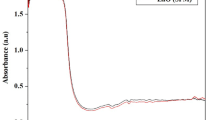Abstract
The Abelmoschus esculentus L. Moench (okra) is much appreciated in the Brazilian regional cuisine, however, the selection of these vegetables for human consumption leads to a large accumulation of biomass, since the pre-selection of this aims to choose only unripe vegetables, and the others are discarded. In this sense, the present work aims to reuse this biomass, using it as a capping/stabilizing agent in the green synthesis of zirconium oxide. For the synthesis, two aqueous extracts of Abelmoschus esculentus L. Moench from the peel and pulp were used together (AEP) and another obtained from the seeds (AES). The syntheses were carried out in a microwave reactor, following the time-power program (5 min/300 W). In this step, a mixture of Zr4+ complexes, phenolic compounds and precursors are obtained, which after lyophilization is coded AEP-Zr and AES-Zr. These materials were characterized by XRD, FTIR and thermoanalytical techniques. In order to evaluate the thermokinetic behavior of these materials, a DTG 60-H (Shimadzu) was used, and in synthetic air atmosphere, the TG-DTG-DTA analyses were performed at rates of (5/10/15/20) °C min−1, with the kinetic parameters being obtained by the Ozawa method. From the analysis of the DTG and DTA curves, it is observed that the complexes obtained are distinct, culminating in different processes for the formation of ZrO2. The AEP-Zr sample presents six main stages of mass loss, while the AES-Zr sample presents five main stages of mass loss. From the kinetic study, it is observed that between 200 and 300 °C are the processes with the highest activation energy (189.27 and 191.54 kJ), associated with the hydroxide transformation phenomena and the crystallization of ZrO2. For the AEP-Zr sample, the event with the highest activation energy (148.27 kJ) is found between 500 and 600 °C and is associated with the possible phase conversion and crystallization of ZrO2, and the energy in this process is lower than in the AES-Zr synthesis. According to master plot method, both samples thermodecomplexation occurs in a sequence of different models, reaffirming the physicochemical and compositional differences of the samples.











Similar content being viewed by others
References
Chakraborty M, Chattopadhyay S, Mondal D, Rana D, Roy S, Chattopadhyay D, et al. Studies on green synthesized silver nanoparticles using Abelmoschus esculentus (L.) pulp extract having anticancer (in vitro) and antimicrobial applications. Arab J Chem. 2015;12:2572–84.
Rana D, Dash SK, Roy S, Sarkar J, Acharya K, Mondal D, et al. Anticancer (in vitro) and antimicrobial effect of gold nanoparticles synthesized using Abelmoschus esculentus (L.) pulp extract via a green route. RSC Adv. 2014;4:37838. https://doi.org/10.1039/C4RA07285E.
Brasil. Lei 12.305/2010 [Internet]. Lei 12.305/2010—Política Nacional de Resíduos Sólidos-PNRS. Brasília: Brasil; 2010. p. 21. http://medcontent.metapress.com/index/A65RM03P4874243N.pdf.
Mota WF, Finger FL, Silva DJ, Corrêa PC, Firme LP, Neves LL. Caracterização físico-química de frutos de quatro cultivares de quiabo. Hortic Bras. 2006;23:722–5.
do Rego A, Alegria E, Ferraria A, Mendes M, Pombeiro A, Ribeiro A. Effect of phenolic compounds on the synthesis of gold nanoparticles and its catalytic activity in the reduction of nitro compounds. Nanomaterials. 2018;8:320.
Ahmed S, Ahmad M, Swami BL, Ikram S. A review on plants extract mediated synthesis of silver nanoparticles for antimicrobial applications: a green expertise. J Adv Res. 2016;7:17–28. https://doi.org/10.1016/j.jare.2015.02.007.
da Silva Sauthier MC, da Silva EGP, da Silva Santos BR, Silva EFR, da Cruz Caldas J, Cavalcante Minho LA, et al. Screening of Mangifera indica L functional content using PCA and neural networks (ANN). Food Chem. 2019;273:115–23. https://doi.org/10.1016/j.foodchem.2018.01.129.
Kadiri O. A review on the status of the phenolic compounds and antioxidant capacity of the flour: effects of cereal processing. Int J Food Prop. 2017;20:S798-809.
Kadiri O, Akanbi CT, Olawoye BT, Gbadamosi SO. Characterization and antioxidant evaluation of phenolic compounds extracted from the protein concentrate and protein isolate produced from pawpaw (Carica papaya Linn.) seeds. Int J Food Prop. 2017;20:2423–36.
Matinise N, Fuku XG, Kaviyarasu K, Mayedwa N, Maaza M. ZnO nanoparticles via Moringa oleifera green synthesis: physical properties and mechanism of formation. Appl Surf Sci. 2017;406:339–47. https://doi.org/10.1016/j.apsusc.2017.01.219.
Chandrababu P, Cheriyan S, Raghavan R. Aloe vera leaf extract-assisted facile green synthesis of amorphous Fe2O3 for catalytic thermal decomposition of ammonium perchlorate. J Therm Anal Calorim. 2020;139:89–99. https://doi.org/10.1007/s10973-019-08376-5.
Maček J, Marinšek M, Novosel B. Study of the drying zirconia gel-precipitates using thermal analysis. J Therm Anal. 1997;48:675–82.
Egger P, Dirè S, Ischia M, Campostrini R. Pyrolysis study of sol-gel derived zirconia by TG-GC-MS. J Therm Anal Calorim. 2005;81:407–15.
Pan M, Liu JR, Lu MK, Xu D, Yuan DR, Chen DR, et al. Preparation of zirconia xerogels and ceramics by sol-gel method and the analysis of their thermal behavior. Thermochim Acta. 2001;376:77–82.
Picquart M, López T, Gómez R, Torres E, Moreno A, Garcia J. Dehydration and crystallization process in sol-gel zirconia. J Therm Anal Calorim. 2004;76:755–61.
Ong CL, Wang J, Ng SC, Gan LM. Effects of chemical species on the crystallization behavior of a sol-derived zirconia precursor. J Am Ceram Soc. 2005;81:2624–8.
George A, Seena PT. Thermal studies on zirconium hydroxide gel formed by aqueous gelation. J Therm Anal Calorim. 2012;110:1037–41.
Ali AAM, Zaki MI. Thermal and spectroscopic studies of polymorphic transitions of zirconia during calcination of sulfated and phosphated Zr(OH)4 precursors of solid acid catalysts. Thermochim Acta. 1999;336:17–25.
USDA. Okra for processing inspection instructions. 1966.
Doyle CD. Estimating isothermal life from thermogravimetric data. J Appl Polym Sci. 1962;6:639–42.
Criado JM, Málek J, Ortega A. Applicability of the master plots in kinetic analysis of non-isothermal data. Thermochim Acta. 1989;147:377–85.
Sánchez-Jiménez PE, Pérez-Maqueda LA, Perejón A, Criado JM. Generalized master plots as a straightforward approach for determining the kinetic model: the case of cellulose pyrolysis. Thermochim Acta. 2013;552:54–9. https://doi.org/10.1016/j.tca.2012.11.003.
Singh S, Prasad Chakraborty J, Kumar MM. Intrinsic kinetics, thermodynamic parameters and reaction mechanism of non-isothermal degradation of torrefied Acacia nilotica using isoconversional methods. Fuel. 2020;259:116263.
Castro JDS, da Silva EGP, Virgens CF. Evaluation of models to predict the influence of chemical pretreatment on the peels of Nephelium lappaceum L. based on pyrolysis kinetic parameters obtained using a combined Fraser-Suzuki function and Friedman’s isoconversional method. J Anal Appl Pyrolysis. 2020;149:104827.
Rietveld HM. A profile refinement method for nuclear and magnetic structures. J Appl Crystallogr. 1969;2:65–71.
Patterson AL. The scherrer formula for X-ray particle size determination. Phys Rev. 1939;56:978–82.
Cui Y, Chen Z, Liu X. Preparation of UV-curing polymer-ZrO2 hybrid nanocomposites via auto-hydrolysis sol-gel process using zirconium oxychloride octahydrate coordinated with organic amine. Prog Org Coat. 2016;100:178–87. https://doi.org/10.1016/j.porgcoat.2016.03.028.
Ricci A, Olejar KJ, Parpinello GP, Kilmartin PA, Versari A. Application of Fourier transform infrared (FTIR) spectroscopy in the characterization of tannins. Appl Spectrosc Rev. 2015;50:407–42.
McDonald M, Mila I, Scalbert A. Precipitation of metal ions by plant polyphenols: optimal conditions and origin of precipitation. J Agric Food Chem. 1996;44:599–606.
Carvalho MS, Virgens CF. Effect of alkaline treatment on the fruit peel of Pachira aquatic Aubl.: physico-chemical evaluation and characterization. Microchem J. 2018;143:410–5. https://doi.org/10.1016/j.microc.2018.08.021.
Selvam NCS, Manikandan A, Kennedy LJ, Vijaya JJ. Comparative investigation of zirconium oxide (ZrO2) nano and microstructures for structural, optical and photocatalytic properties. J Colloid Interface Sci. 2013;389:91–8.
Doreddula SK, Bonam SR, Gaddam DP, Srinivasa B, Desu R, Ramarao N, et al. Nootropic activities of aqueous and methanolic seed extracts of ladies finger (Abelmoschus esculentus L.) in mice. Sci World J. 2014;2014:14.
Shinde HM, Bhosale TT, Gavade NL, Babar SB, Kamble RJ, Shirke BS, et al. Biosynthesis of ZrO2 nanoparticles from Ficus benghalensis leaf extract for photocatalytic activity. J Mater Sci Mater Electron. 2018;29:14055–64. https://doi.org/10.1007/s10854-018-9537-7.
Rafiq M, Siddiqui H, Al-wassil AI. Effects of precursor on the morphology and size of ZrO2 nanoparticles, synthesized by sol-gel method in non-aqueous medium 3. Results Discuss. 2012;15:986–9.
Bukhari BS, Imran M, Bashir M, Riaz S, Naseem S. Honey mediated microwave assisted sol–gel synthesis of stabilized zirconia nanofibers. J Sol-Gel Sci Technol. 2018;87:554–67. https://doi.org/10.1007/s10971-018-4749-0.
Duan H, Wang D, Li Y. Green chemistry for nanoparticle synthesis. Chem Soc Rev. 2015;44:5778–92. https://doi.org/10.1039/C4CS00363B.
Mittal AK, Chisti Y, Banerjee UC. Synthesis of metallic nanoparticles using plant extracts. Biotechnol Adv. 2013;31:346–56.
Agarwal H, Venkat Kumar S, Rajeshkumar S. A review on green synthesis of zinc oxide nanoparticles: an eco-friendly approach. Resour Effic Technol. 2017;3:406–13.
Gowri S, Rajiv Gandhi R, Sundrarajan M. Structural, optical, antibacterial and antifungal properties of zirconia nanoparticles by biobased protocol. J Mater Sci Technol. 2014;30:782–90. https://doi.org/10.1016/j.jmst.2014.03.002.
Abu El-Fadl A, Eltokhey AM, Abu-Sehley AA, El-Attar HM. Fabrication and analysis of the structural phase transition of ZrO2 nanoparticles using modified facile sol–gel route. Phase Transit. 2019;92:36–51. https://doi.org/10.1080/01411594.2018.1545904.
Balaji S, Mandal BK, Ranjan S, Dasgupta N, Chidambaram R. Nano-zirconia–evaluation of its antioxidant and anticancer activity. J Photochem Photobiol B Biol. 2017;170:125–33.
Ouyang H, Li C, Li K, Li H, Zhang Y. Effect of pH on crystallization of nanocrystalline zirconia in a microwave-hydrothermal process. J Wuhan Univ Technol Mater Sci Ed. 2016;31:68–73.
Xie S, Iglesia E, Bell AT. Water-assisted tetragonal-to-monoclinic phase transformation of ZrO2 at low temperatures. Chem Mater. 2000;12:2442–7.
Figueiredo JL, Ribeiro FR, de Melo Orfão JJ, Lemos F. Catálise heterogênea. 2007.
Santos V, Zeni M, Bergmann CP, Hohemberger JM. Correlation between thermal treatment and tetragonal/monoclinic nanostructured zirconia powder obtained by sol-gel process. Rev Adv Mater Sci. 2008;17:62–70.
Štefanić G, Musić S. Factors influencing the stability of low temperature tetragonal ZrO2. Croatica Chem Acta. 2002;75:727–67.
Ostwald ripening. IUPAC compendium of chemical terminology. 2008;1801:4348.
Varma PCR, Colreavy J, Cassidy J, Oubaha M, Duffy B, McDonagh C. Effect of organic chelates on the performance of hybrid sol-gel coated AA 2024–T3 aluminium alloys. Prog Org Coat. 2009;66:406–11.
Galwey AK, Brown ME, editors. Chapter 3: Kinetic models for solid state reactions. Studies in physical and theoretical chemistry [Internet]. Elsevier; 1999. p. 75–115. https://www.sciencedirect.com/science/article/pii/S0167688199800044.
Khawam A, Flanagan DR. Solid-state kinetic models: basics and mathematical fundamentals. J Phys Chem B. 2006;110:17315–28.
Fukuda M, Koga N. Kinetics and mechanisms of the thermal decomposition of copper(II) hydroxide: a consecutive process comprising induction period, surface reaction, and phase boundary-controlled reaction. J Phys Chem C. 2018;122:12869–79.
Djurado E, Bouvier P, Lucazeau G. Crystallite size effect on the tetragonal-monoclinic transition of undoped nanocrystalline zirconia studied by XRD and Raman spectrometry. J Solid State Chem. 2000;149:399–407.
Acknowledgements
The authors thank the funding agencies FAPESB and CAPES for granting the scholarships and the post-graduation programs PGQA (UNEB) and PPEQ (UFBA) and IFBaiano- Catu for the infrastructure provided.
Funding
Partial financial support was received from CAPES, via Master’s Scholarship between 2018 and 2019, for João Daniel S. Castro. A scholarship was received from FAPESB, via IC program, between 2018 and 2020 for Edinilson Ramos Camelo. All authors declare that they have no affiliations or involvement in any organization or entity with any financial or non-financial interest in the subject matter or materials discussed in this manuscript.
Author information
Authors and Affiliations
Contributions
All authors contributed to the study conception and design. Material preparation, data collection and analysis were performed by JDSC, ERC and CFdV. The first draft of the manuscript was written by JDSC and ERC; and all authors commented on previous versions of the manuscript. All authors read and approved the final manuscript.
Corresponding author
Additional information
Publisher's Note
Springer Nature remains neutral with regard to jurisdictional claims in published maps and institutional affiliations.
Rights and permissions
Springer Nature or its licensor holds exclusive rights to this article under a publishing agreement with the author(s) or other rightsholder(s); author self-archiving of the accepted manuscript version of this article is solely governed by the terms of such publishing agreement and applicable law.
About this article
Cite this article
Camelo, E.R., Castro, J.D.S. & das Virgens, C.F. Thermokinetic evaluation of zircon oxide green synthesis mediated by plant extract of Abelmoschus esculentus L. Moench. J Therm Anal Calorim 148, 49–62 (2023). https://doi.org/10.1007/s10973-022-11586-z
Received:
Accepted:
Published:
Issue Date:
DOI: https://doi.org/10.1007/s10973-022-11586-z




